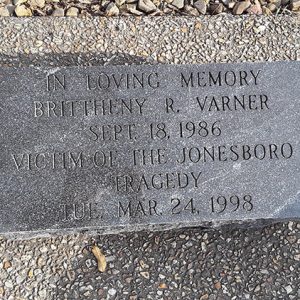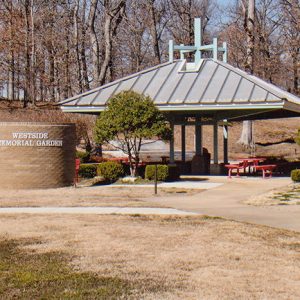calsfoundation@cals.org
Westside School Shooting
In the early afternoon of March 24, 1998, two students from Westside Middle School, located approximately two miles west of Jonesboro (Craighead County), conducted an armed ambush on teachers and students, which resulted in five dead and ten others injured. The shooters, Andrew Golden and Mitchell Johnson, were arrested and prosecuted for the crime. The incident was one of two school shootings in Arkansas and one of several school shootings across the nation that adjusted school administrators’ and law enforcement officers’ concepts on school security and response plans to violent incidents at schools.
The students and teachers had returned from spring break the day before the shooting. Fifth period was just starting at 12:35 p.m. when a fire alarm caused the student body and faculty to evacuate the building. This alarm was triggered by eleven-year-old Andrew Golden, who, shortly after activating the alarm, joined thirteen-year-old Mitchell Johnson in a field adjacent to the school. This location had a clear view of the exit doors used during a fire drill. At 12:41 p.m., as eighty-seven students and nine teachers evacuated the building, Golden and Johnson began firing at the group with various weapons, including handguns and semi-automatic and bolt action rifles. In rapid succession, Golden and Johnson fired thirty rounds at the group.
Sixth-grade teacher Shannon Wright was killed, along with four students: Natalie Brooks (age eleven), Paige Ann Herring (age twelve), Stephanie Johnson (age twelve), and Brittheny Varner (age eleven). Nine students and another teacher, Lynette Thetford, were injured. Among the wounded students were Candice Porter (age eleven), who reportedly dated and broke up with Johnson, and Jennifer Jacobs (age twelve), who reportedly dated and broke up with Golden prior to the shooting. Although some speculated the suspects targeted specific students or teachers based upon past interactions, this theory was never proven and the victims’ association to the suspects was eventually considered coincidental. After firing upon the crowd, both suspects fled through the woods and were apprehended by the police without further violence.
The police discovered that the boys were attempting to make their way back to a van parked almost half a mile away from the school. This van, taken from Johnson’s residence, contained food, extra clothing, and camping equipment to facilitate their escape. An investigation by the police determined that three handguns were taken from Golden’s residence and an additional four handguns and three rifles came from Golden’s grandfather’s residence. The Craighead County Sheriff’s Office assumed responsibility for the investigation of the incident and charged both suspects with five counts of capital murder and ten counts of first-degree battery.
By all accounts, the two suspects were not close friends. In fact, with Johnson attending the seventh grade and Golden attending the sixth grade, the students only shared bus rides to and from school. But both verbalized hostility toward others and threatened that something big was about to happen. Johnson lived with his mother and stepfather, and had a difficult relationship with his father. Fellow students reported that Johnson was bullish and bragged about being in a gang. Within the same school year as the shooting, Johnson was assigned in-school suspension three times and was criminally charged for molesting a two-year-old girl. In contrast to Johnson’s overt behavioral problems, Golden led a kind of “Jekyll and Hyde” lifestyle. Golden was not a disciplinary problem at school and was regarded by many adults as a well-mannered and cheerful student. He was very close to his family and shared the family’s interest in firearms by competing and winning marksmanship awards. However, apparently unbeknownst to his family, Golden reportedly demonstrated violence by firing his BB gun at animals and other children.
On his birthday, August 11, 1998, Johnson pleaded guilty to all charges. A trial against Golden was held the same day, and in just over three hours, he, too, was found guilty on all charges. Judge Ralph Wilson of the Fifth Division Circuit Court in Osceola (Mississippi County) presided over the case, which was tried by Deputy Prosecutor Mike Walden of Craighead County. Walden was unable to charge the suspects as adults because they did not meet the minimum age of culpability, which is fourteen, at the time of the incident. After the convictions, both suspects were placed in the Department of Youth Services Facility in Alexander (Saline County). In 1998, Arkansas did not have a provision in the law that would allow juveniles to serve life sentences for heinous crimes. Although Judge Wilson added additional time to their sentences due to the aggravated circumstances and weapons violations, both suspects were scheduled for release upon their twenty-first birthdays (2005 for Johnson and 2007 for Golden).
The shooting at Westside Middle School was instrumental in pushing legislative action to allow prosecutors discretion in charging juveniles as adults. In 1999, the Arkansas General Assembly passed Act 1192, the Extended Juvenile Jurisdiction Act. This act allowed prosecutors to charge juveniles under the age of fourteen as adults for offenses of capital murder and first-degree murder, and to include adult sentencing guidelines commensurate with the seriousness of the offense. The legislature additionally passed Act 1272, requiring the Department of Youth Services to establish a separate facility for individuals between the ages of eighteen and twenty-one.
The incident at Westside Middle School was not the first school shooting to occur in the state. On December 15, 1997, a fifteen-year-old student in Stamps (Lafayette County) conducted a similar ambush-style attack, firing upon students from a nearby wooded area. It is unknown whether Johnson or Golden had any knowledge of the details of this attack, but the similarity and timing is remarkable. The Westside School Shooting is also similar to the massacre at Columbine High School on April 20, 1999, near Littleton, Colorado. This attack, just over one year later, is the only other multi-suspect incident involving students attacking fellow classmates.
The events that unfolded on March 24, 1998, at Westside Middle School catapulted Jonesboro into the national and international spotlight because of concerns about the growing number of school shootings during the late 1990s. The enormous influx of media personnel added tension to the resident population’s ability to heal from the event. In spite of this outside influence, the Jonesboro Sun was recognized in 1999 as one of two Pulitzer Prize finalists for the Breaking News Reporting category.
Within two weeks of the shooting, Arkansas State University (ASU) hosted a memorial service for the victims. Almost 9,000 mourners attended, including Janet Reno, the attorney general of the United States. The community eventually erected a memorial garden on the campus but away from the actual location of the shooting. Curtis Steele, the chair of the Department of Art at ASU, donated a sculpted sundial in memoriam to the victims of the shooting; it is on display in the Westside Middle School Memorial Garden.
Mitchell Johnson and Andrew Golden were both released on their twenty-first birthdays, in 2005 and 2007, respectively. Johnson was arrested and charged with a variety of drug, theft, and weapons crimes starting in 2007. In July 2015, after serving several years in prison, he was released into the custody of the U.S. Probation Office for the Southern District of Texas and placed in a drug rehabilitation program. Golden legally changed his name to Drew Grant; this fact became public when, in 2008, he applied for a concealed carry permit but was denied. On August 14, 2017, Judge John Fogleman of the Craighead County Circuit Court awarded the families of the Westside victims $150 million in damages as resulting from the 1998 shooting. The ruling was seen as largely symbolic; neither Golden nor Johnson appeared in court to contest the judgment. Golden was killed in a car accident in Missouri on July 27, 2019.
For additional information:
Brown, Carleton H. “School Counselors Lived Experience of a Rampage School Shooting.” PhD diss., University of Arkansas, 2015. Online at https://scholarworks.uark.edu/etd/1321/ (accessed August 26, 2023).
Burns, Richard Allen. “‘Our Friends Have Given Consolation’: Communal Response to the Jonesboro School Shootings.” Southern Folklore 56.2 (1999): 161–179.
Grant, George, and Mike Huckabee. Kids Who Kill: Confronting Our Culture of Violence. Nashville, TN: B& H Publishing Group, 1998.
Harding, David J., Cybelle Fox, and Jal D. Mehta. “Studying Rare Events through Qualitative Case Studies: Lessons from a Study of Rampage School Shootings.” Sociological Methods and Research 31 (November 2002): 174–217.
Keneally, Meghan. “The Only Two Living US Mass School Shooters Who Are Not Incarcerated.” ABC News, February 17, 2016. https://abcnews.go.com/US/living-us-mass-school-shooters-incarcerated/story?id=36986507 (accessed August 26, 2023).
Koon, David. “A Boy Killer Speaks.” Arkansas Times. December 4, 2008, pp. 12–14, 16. Online at https://arktimes.com/general/top-stories/2008/12/05/a-boy-killer-speaks (accessed August 26, 2023).
Peisner, David. “The Ghosts of Jonesboro: Fifteen Years after a School Shooting, a Small Town Is Still Recovering.” BuzzFeed. http://www.buzzfeed.com/djpeisner/the-ghosts-of-jonesboro-fifteen-years-after-a-notorious-scho (accessed August 26, 2023).
Roberts, Jeannie. “20 Years Ago, Sad Day at Westside.” Arkansas Democrat-Gazette, March 18, 2018, pp. 1A, 10A–11A. Online at https://www.nwaonline.com/news/2018/mar/18/20-years-ago-sad-day-westside/ (accessed August 26, 2023).
Roth, Wendy D., and Jal D. Mehta. “The Rashomon Effect: Combining Positivist and Interpretivist Approaches in the Analysis of Contested Events.” Sociological Methods and Research 31 (November 2002): 131–173.
Jonathan Ford
Arkansas Army National Guard
 Shooting Tribute
Shooting Tribute  Westside Memorial
Westside Memorial  Westside Middle School
Westside Middle School 




Comments
No comments on this entry yet.